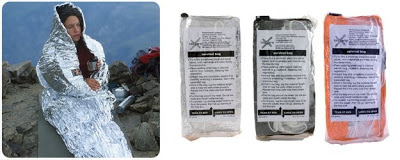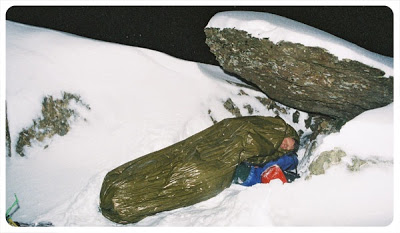
Just received this email from cybr-c, drawing my attention to an intriguing product:
I don't know about anyone else...but I'm always looking for something that is light and don't take up much room in my ruck. This is an item that I think I will order and add to my deployment gear. Let me know what you think?

Now the first thing that strikes me as a boy who was born in Michigan and raised in Ohio is that a system that is "equal to a medium weight regular sleeping bag" is not going to save you from a blizzard. But that marketing hyperbole aside, it still could be of use. I also note that it is available in OD Green.

Are there any Three Percenters out there who have experience with this system? Please post your evaluation(s) if you do.
Mike
III
Blizzard Survival Sleeping Bag
$34.95
Tested and recommended by renowned mountaineer and Wilderness EMT Jon Bentley!
The Blizzard Survival Bag is a full-sized sleeping bag in a pack the size of a video cassette, providing total warmth and shelter – anywhere, at any time. It’s made from our unique Reflexcell™ material, which blocks heat loss more effectively than any other thermal emergency product. The bag also contains elastic, causing it to hug the body, giving a great feeling of warmth and security.
How does it work?
Reflexcell™, the base material for Blizzard’s unique products, has major advantages over existing materials and is revolutionizing emergency thermal protection.
Reflexcell™ utilizes cellular construction to trap warm air. Its elasticity draws the material to the body and reduces cold spaces and heat loss by convection. Its silvered surfaces block heat loss by radiation. It is also completely waterproof and windproof.
Reflexcell’s™ greatest strength is that it can be compressed into the tiniest of packages and stored indefinitely without damaging its performance.
Benefits
Very warm
Light weight
Compact vacuum packaging
Durable and reusable
Waterproof
Windproof
Versatile
Adaptable
Performance
Warmth: 8 Togs – equal to a medium weight regular sleeping bag
Weather Protection: Fully waterproof and windproof
Storage: Bags may be stored indefinitely, and are not affected by temperature or moisture, wither during storage or in use.
Portability: The bags’ small size and light weight make them easy to carry, whether as personal safety equipment, or for rapid deployment in emergencies involving large groups of people
Reusability: Bags can be reused many times without loss of performance
Specifications
Vacuum Pack Dimensions: 8.4 x 4.3 x 1.2 in
Volume: 0.2 gal
Weight: 12.3 oz
Size unpacked: 6.9 ft (fully stretched)
Features
- Top may be closed to form hood
- Draw cord with spring toggle
- Fits fully clothed large adult
- Reusable
8 comments:
While we haven't had experience with this particular product, like many like-minded and prepared folks, we do keep 'space blanket' mylar type bags in our survival kits. They cost a couple bucks and are used a few times before they tear or otherwise become unservicable. They're great for emergency use (wrap up in or to put under a regular sleeping pad to help reflect body heat) but they have a large drawback that we teach our folks to watch for: the trapping of moisture inside the bag over longer periods of use (like a few hours of sleep).
After only reveiwing the site, and not having one (don't know if we want to expend $35 to find out, either), we suspect these bags are constructed along the same lines and will have the same issues with condensation.
That's the major drawback we see on this product.
We believe this tool should be kept in the survival portion of the ruck. At least in the North country.
And MBV is right, it won't save you in a blizzard or keep you from hypothermia when laying in the snow as shown in the advertisement...at least, not without a good fire close by.
Looks like it might be passable for spring and fall in a temperate zone, but NOT winter. The ad says 'completely waterproof' and never mentions the word 'breathable'. The last thing you want is to wake up soaking wet, then have to pack away a wet bag. The ad implies that this bag is good for blizzard conditions. I highly doubt that. Being cold and dry is MUCH better than being warm and wet. Eventually, you have to come out of that bag. If you are wet and freezing, you will likely die.
If you have never draped a poncho over your sleeping bag before going to sleep in winter weather, you should try it once. (Make sure you do this in a safe place where you have access to a warm shelter after you wake up soaking and freezing) You will come away with a new understanding of unintended consequences! lol
"...and reduces ... heat loss by convection."
Hmmm. In this era of thermal detection equipment, walking around with that stuff around your body and head would seem to make one less visable. Oh, and lots warmer - so bring along a bunch of water. But in the middle of the night in a cold climate, reducing one's thermal signature wouldn't be a bad thing, would it?
Of course, both cheaper and not quite so hot would be the simple thermal blankets you see everywhere.
I wonder if anyone has done a study on the effectiveness of this type of exercise????
I live in South Florida, so thermal conservation isn't an issue. I have the plain mylar "space blanket" sleeping bag. They were 2/$7, not $35/ea. I also have the flat panels, aka space blankets which will be sewn into a shelter half to spoof IR detectors. Those were 4/$8; you gotta love eBay, supplier to the 3%...
:)
Hmmmm, I wonder how it holds up when wet.
I like Wiggy's gear. www.wiggys.com
Certainly more expensive, but you get what you pay for. His bags will keep you warm even when wet, and have great insulation properties for the weight.
Wiggy's ultralight bag is only 3 lbs and rated down to 20 degrees, and when you add in the overbag (rated at 35 degrees), and use the two bags together (the FTRSS system), you can then go down to -20. And that combo is only 6 lbs. total.
I'll find room in my ruck for 6 lbs of gear that WILL keep me alive through a blizzard, even when wet (when combined with some form of shelter, even just a poncho or improvised snow trench).
If you need to go down lower in temp, then go with the Ultima Thule bag, rated at -20. When you combine that with the overbag, for the FTRSS, it is good down to -60.
And the Ultima Thule weighs 5 lbs. So, for a total of 8 lbs. of sleeping bag, you can go to -60 (in a shelter of some kind, and with ground pad - but you can improvise both).
If someone knows of a better system, please post, but I have been using Wiggy's gear for many years and his gear works.
at around 3/4 of a pound, this product reminds me of a "season stretcher". If you have a sleeping bag or a few blankets, this kind of reflective waterproof shell can keep you much warmer than just a tarp. I suspect that a user tucked unto a bag like this has a much-lowered IR signature.
While repairing the rotted insides of a travel trailer, I used an 3/8th's inch thick aluminumized waterproof bubble sheet product sold as an insulator for walls. I installed it between the outer aluminum skin and the wooden framing, then filled wall voids with fiberglass batting. It's rated as R-3, but seems much more effective than R-3 worth of fiberglass batting. This sheet material can be sewn into envelopes to be used as a sleeping bag cover or reflective/insulating floor mat for ice camping.
cheers.
Wiggy's Superlight might be a better way to go for those in cold areas.
It weighs 4 lbs. and is rated at 0 degrees, and when combined with the overbag (FTRSS), is good down to -40.
Not knocking the blizzard survival bag - it would be a good addition to a butt-pack or a day pack when you are not expecting really fowl weather- but if you are in areas where you are in danger of a blizzard, it may be a good idea to bring a real serious bag along.
Who has a FLIR thermal imaging device to borrow from work overnight? Firefighters, some detectives, folks who do building energy efficiency surveys.
A survey of common materials effectiveness in obscuring detection would be fun to see.
Man-sized target, hot from exercise and still/cool against a hot summer moonless background and the same in winter: shirtless, t-shirt, jacket, parka, heavy canvas, behind/under pocket space blanket, behind/under tarp reflective blanket, in ditch, in hole, behind brush, behind trees and in combinations. At different ranges, with limits exceeded.
I wish.
cheers.
Post a Comment